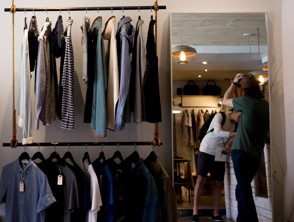5 Ways Facial Recognition Technology Is Going To Change Things Around You

How Facebook is able to identify the appropriate individual’s face to tag or smartphones are easing our task to earmark photos of our friends and families and organize them. The power of this technology is not restricted to these areas and it seems to be unstoppable.
Facial recognition is an emerging technology that has the potential to augment the way people live or appreciably shape the digital world in the next five years. It is a biometric technology that scans people’s face or photographs and recognizes an individual. It discerns facial features like space between the eyes, depth of the eye sockets, the width of the nose, cheekbones, and jawline. The software reads approximately 80 nodal points designed from a numerical code, called a faceprint and records it in its database. Once the faceprint is recorded the software compares a person’s face from the data captured.
More than half of the American population’s faceprint is recorded in a facial recognition database. According to Transparency Market Research(TMR) report, “the global facial recognition market has gained popularity from diverse emerging tech trends, whether it’s switching from 2D facial recognition technology to 3D and facial analytics. Because of the higher accuracy in terms of identifying facial features, the market for 3D facial recognition technology segment is expected to record faster growth as compared to 2D facial recognition technology during the forecast period. In addition, a growth of the market for facial analytics, an emerging technology used for examining facial images of people without disturbing their privacy, is further expected to record steady growth as compared to that for 2D facial recognition technology.”
“The global facial recognition market will grow steadily at a CAGR of close to 23% by 2021.”
-Technavio
In China, employees use their faces to get an entry in their office building. There are multiple industries who are increasingly adopting this emerging technology such as healthcare, retailers, hospitality industries, manufacturing and so many. How are recognition systems impacting all these industries?
Here are the 5 ways facial recognition technology is changing things around us.
1. Payments
Facial recognition is creating a huge buzz today in the market. The technology has been rapidly picked up by restaurants and retail to accelerate the cashless economy. A few years back, a financial services company, MasterCard introduced “selfie pay” a biometric mobile payment authentication app. The app allowed users to confirm a payment simply by using their camera. Fast food giant Caliburger is gaining customer engagement with facial recognition technology to identify loyalty program members without loyalty card swiping at the store. This saves both the parties time and escalates customer experience.
John Miller, CEO of Cali Group said, “face-based loyalty significantly reduces the friction associated with loyalty program registration and use; further, it enables a restaurant chain like CaliBurger to provide a customized, one-on-one interactive experience at the ordering kiosk. Our goal for 2018 is to replace credit card swipes with face-based payments. Facial recognition is part of our broader strategy to enable the restaurant and retail industries to provide the same kinds of benefits and conveniences in the built world that customers experience with retailers like Amazon in the digital world.”
2. Access and security
Facial recognition technology is set to go mainstream in 2018. It will not only change the digital world but enhance the way we live or work. Processing payment is not the only thing this technology is capable of. The usage of facial biometrics is enormous and is going to be omnipresent. House or car owners will be soon able to access all these with their facial features. No more worrying about losing car or house key. Unlocking smartphones are already out on the market today. Apple has recently launched their new iPhone X that uses face ID to unlock the user’s phone. The unique feature had tugged everyone’s attention. Several companies have already adopted this technology and few are potential to take advantages of the FRT technology to secure their sensitive data and manage it.
3. Criminal identification
Police and security forces are the keenest to integrate facial recognition technology to verify citizen identities by analyzing their faces. In 2017 the software helped Chinese police to spot out 25 criminals at the Qingdao Beer Festival. The technology can recognize one face from millions in just one second, an additional security level designed for people’s safety. It has a high accuracy rate of around 99% in a supervised traffic. Likewise, other countries like UK, US, Russia, Germany are using facial recognition technology to control security risks. Having more than half of the population’s faceprint sounds unusual but it is actually helping all the lawkeepers to track down criminals across the country and keep all the citizens safe.
4. Advertising
FacTech has benefited advertising industries in boosting customer engagement, marketing, advertising and so much more. The power to identify one individual from millions has given advertisers an opportunity to offer more personalized product or services to their targeted audiences. The technology allows advertisers to reach their audiences outside their homes digitally (DOOH) with creative and innovative messages based on the studied demographics. As the technology keeps evolving, DOOH is going to become an essential part of the digital world. DOOH can recognize a customer’s emotional state and show a relevant ad. US is foreseen to spend around $4 billion on DOOH advertising in the next two year. Similarly, UK giant supermarket, Tesco are the early ones to adopt OptimEyes to run personalized ads based on the customers’ age and gender. For example, if the customer is a male between the ages of 15 and 20, the system might display an ad showing what drinks he can pick.
“MarketsandMarkets estimates sales of facial recognition software and equipment were $2.8 billion worldwide last year and forecasts they will increase to $6.19 billion by 2020.”
5. Healthcare
You walk into the hospital and the person sitting at the front desk calls you by your name and quickly assigns you to the medical help that suits your ailment. Surprised? Yup, it’s a FaceTech camera that identifies you and your data, which helps you check in quicker and direct you to your physician’s room. Your physician examines you and writes prescriptions which will automatically be sent to the drugstore and by simply verifying your biometric identity you get the medicines home, without carrying any single piece of paper. This allows healthcare industries to secure their patient’s data by using a facial recognition technology. According to Market research future, “global healthcare biometrics market is expected to grow USD 5.6 billion at the CAGR of 22.3% by 2022.
You can unlock your house door with your face or pay your bills, order foods, pass security checkpoints. Apple launched their new iPhone with facial recognition feature to unlock the phone. KFC in Beijing uses customers’ faces to recommend meal items based on their age, gender and mood – Forbes report. Also, luxury retailers in Europe are using this technology to recognize their VIP customers to offer special care. Airports in Australia use facial recognition technology to allow passengers fly without carrying their passport and soon this technology is going to be used in US airports. Sounds strange but this is going to be our future soon.
![Blog-[x]cube LABS](https://d6fiz9tmzg8gn.cloudfront.net/wp-content/uploads/2016/06/blog_banner.jpg)





